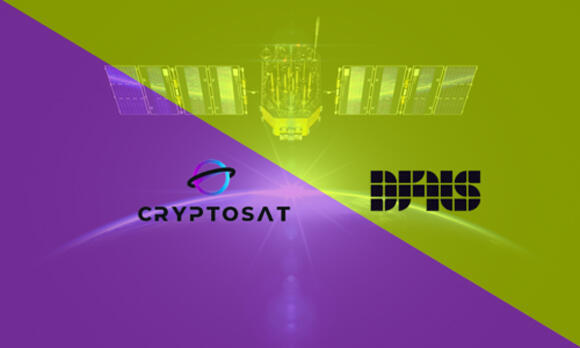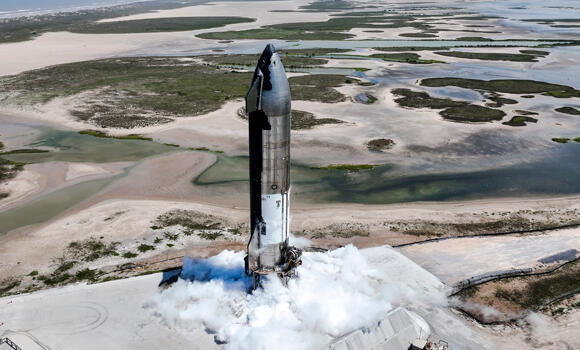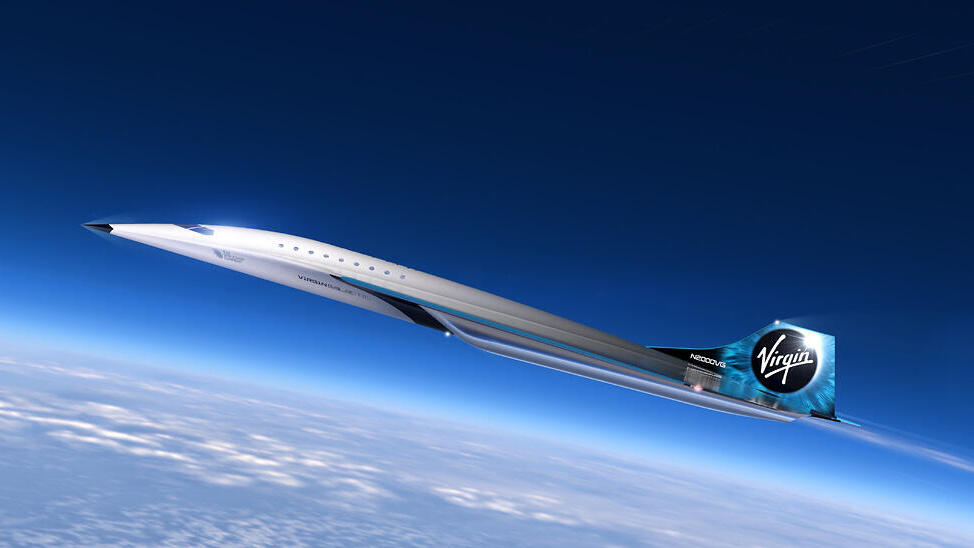Getting your Trinity Audio player ready...
Cryptosat, a company founded by two Israelis in the United States, is really expanding its horizons and has recently forged a partnership with the American firm Dfns. The collaboration aims to pioneer the development of the world’s first 'space wallet' by harnessing the power of blockchain technology.
More stories:
Cryptosat, established about a year and a half ago by Dr. Yan Michalevsky, an information security expert, and Yonatan Weintraub, one of the key figures behind the Israeli lunar spacecraft project Beresheet. Weintraub is currently leading a project aimed at cultivating chickpeas in space. At the same time, Cryptosat operates two tiny satellites, providing highly secure computing services from space, and offering unparalleled physical security beyond the reach of hackers.
3 View gallery


Making use of the space-based digital wallet: The partnership between Dfns and Cryptosat | Companies' logo
(Davidson Institute)
"No one can just come and take the memory card with the information. Communication with it is done in a very secure way," Weintraub said. "We offer services to those for whom physical security is crucial, and the alternative is to guard the computer, which is obviously much more expensive."
"A digital wallet is a service enabling secure transactions in blockchain, such as making payments in digital currencies like Bitcoin. There are private wallets, company wallets and shared wallets where, for example, approval from several factors is required to make a transfer," Michalevsky explains. "We heighten the security by having one of these factors, or the keys, in space. That means there's no physical access to it. This ensures, for instance, that a fraudster cannot unilaterally approve a transaction and steal digital money."
Dfns, established in 2020, specializes in secure information and digital wallets. The collaboration with Cryptosat takes digital wallets into space, offering secure transactions with technology developed by the Israelis. The specifics of the deal, including its financial value, remain undisclosed.
Cryptosat, with some 10 employees, plans to construct a third satellite that is scheduled for launch later this year aboard a SpaceX rocket. "Each satellite houses computers and memory cards. We buy some of the components ready-made, and we manufacture others ourselves. That enables us to produce and launch satellites at a reasonable cost," Michalevsky reveals. "With each satellite, we advance and grow more sophisticated, aiming to amass a whole fleet of such satellites."
"Blockchain is an industry with a current annual turnover exceeding $1 billion dollars, providing faster and more efficient solutions compared to traditional technologies," Weintraub adds. "Our goal is to forge partnerships with more companies in the field."
A remarkably different experiment
The timeline for SpaceX's next Starship launch experiment remains hazy, but it's evident that this spacecraft will have many differences from the one used in the initial test. The maiden launch in April this year culminated in the explosion of the spacecraft and launch rocket following a separation malfunction.
“There are really a tremendous number of changes between the last Starship flight and this one, well over a thousand,” said SpaceX founder and CEO Elon Musk in a Twitter Spaces discussion. “I think the probability of this next flight working, getting to orbit, is much higher than the last one. Maybe it's like 60%. It depends on how well we do at stage separation,” he added.
3 View gallery


Starship 25 during the engine test at SpaceX's space base in Texas, June 26, 2023
(Photo: SpaceX)
The most crucial change pertains precisely to this separation between the launch rocket and the spacecraft. In the forthcoming experiment, the company plans to execute a "hot separation" – that is, activating the spacecraft engines while still connected to the launch rocket, and even prior to the complete shutdown of its engines. This necessitates a structural modification, introducing a gap between the spacecraft and the rocket, to allow gases ejected from its engines to vent without igniting the rocket itself, or potentially causing an explosion. The benefit of a hot separation is the enhanced probability of the second stage's successful operation – in this case, the spacecraft itself. While this isn't a new technology – Russian rockets have employed hot separations for decades – it is a technically intricate process prone to errors, especially when untried.
Other modifications involve the launch rocket engines. After seven out of the 33 engines failed to operate properly in the first trial, the company is altering the engine fuel supply system to minimize the risk of additional failures. Further significant enhancement will include fortifying the launch pad, which suffered severe damage in the first trial. The launch pad will be reinforced with steel plates, and a water pipe system will be added to swiftly cool the pad, thereby reducing damage.
The big question revolves around the timing of the experiment. Musk reiterated in the interview that the spacecraft, rocket and launch pad at the South Texas space base should be ready in roughly six weeks, as he promised two weeks ago. However, SpaceX is also grappling with restrictions imposed by the Federal Aviation Administration in the United States due to the outcomes of the previous experiment. It remains uncertain whether the company will secure approval for another test at this time.
In the meantime, the company successfully completed an engine test this week for the spacecraft intended for launch in the next experiment, Starship 25. In the static fire test, the engines were ignited without initiating a launch, and all six engines functioned properly, albeit for a very brief duration of approximately five seconds.
Space tourists return
Two years after its inaugural experimental flight to the edge of space, Virgin Galactic has successfully executed its first-ever tourism flight along this route. The spacecraft, SpaceShipTwo, which carried four passengers and two pilots, was launched with the carrier aircraft, Eve, from the company's spaceport in New Mexico. Upon reaching an altitude of 15 kilometers, the aircraft released the spacecraft. Its rocket engine then propelled it to a height of 83 kilometers, where the passengers enjoyed a few minutes of weightlessness before the spacecraft descended and landed like an airplane on a runway, approximately 90 minutes after the initial takeoff.
3 View gallery


Virgin Galactic is ready to carry space tourists into the stratosphere
(Photo: Virgin Galactic)
The company initially ventured to the edge of space in 2021, with senior company employees as passengers, led by the owner, Richard Branson. However, the project encountered a series of setbacks, primarily due to issues with the carrier aircraft. It was only in May of this year that the company conducted another test flight, again with company employees. Last week was its first flight carrying three paying tourist passengers. To be precise, the tickets were purchased by the Italian Air Force and the Italian Research Council (CNR) on behalf of their personnel, who took advantage of the brief time at the edge of space to conduct scientific experiments. Accompanying them was Virgin Galactic's astronaut trainer, Colin Bennett, who had also been part of the inaugural flight two years prior.
The company now plans frequent space tourism flights, at least once a month, and to soon deploy additional spacecraft. Virgin Galactic has already sold several hundred tickets for its flights, currently priced at $450,000 per ticket, and plans to deliver on these promises while also starting to offset the losses accumulated over recent years. With growing competition in the field of tourist flights to the edge of space, Virgin Galactic's passengers may soon experience a true rivalry. One such competitor is Jeff Bezos's Blue Origin, which offers a slightly different experience, launching tourists aboard rocket-propelled spacecraft that then gracefully parachutes back to Earth.
A long way to Mars
Last week, four intrepid crew members embarked on a year-long mission to Mars, not in space but in Houston, Texas. They commenced an analog mission, mimicking a spaceflight to Mars, as part of a NASA experiment focused on crew health and performance. The four volunteers will spend the upcoming year in a 3D-printed living complex spanning 158 square meters. Their only outdoor excursions will consist of 'field activity’ on Mars-like terrain, carried out in a closed, sandy yard, and fully suited in spacesuits.
The CHAPEA mission, short for "Crew Health and Performance Exploration Analog," is designed to investigate aspects of crew performance under conditions that simulate a Mars mission, at least to some extent. The crew will be isolated, with limited communication with the control center due to time lags resulting from the simulated distance from Earth, which will prevent real-time problem-solving. They will also consume pre-packaged food supplies for the mission without receiving any fresh provision. Additionally, they'll have to tackle mission-related challenges and conduct experiments and research.
The crew members voluntarily signed up for the mission and were selected from a large pool of candidates through a selection process similar to that of real astronauts. The team commander is Kelly Haston, a biologist specializing in disease research; mission engineer is Ross Brockwell, a certified construction engineer; and the mission doctor is Nathan Jones, an emergency medicine specialist. The team scientist is Anca Selariu, a microbiologist serving in the US Navy.
"The team will also have to contend with a multitude of unexpected problems during the mission," said Suzanne Bell, the project coordinator for the American Space Agency. "But if we address them now, they will no longer catch us off guard."

